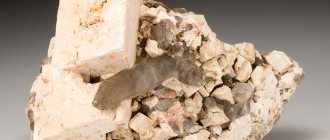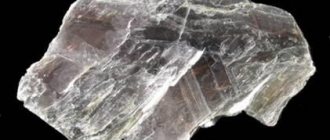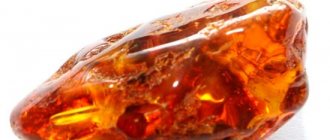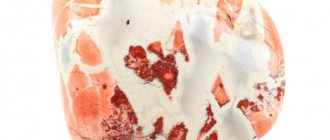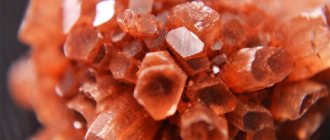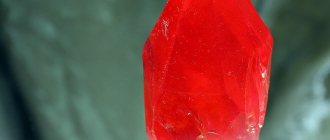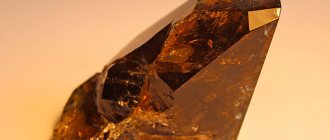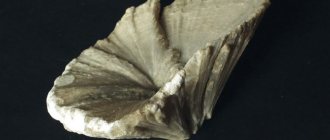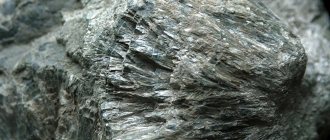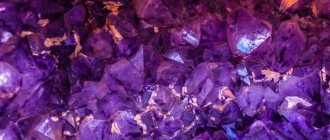- What kind of stone: Ornamental;
- Deposits: Russia (Urals, Karachay-Cherkessia, Krasnoyarsk Territory, Buryatia, Transbaikal and Khabarovsk Territories;
- Colors: Soft pink, matte, transparent pink, raspberry, dark cherry;
- Mohs hardness: 5.5-6.5;
- Transparency: Transparent, translucent;
- Density: 3.5—3.75 g/cm³;
- Formula: (Mn2+,Fe2+,Mg,Ca)SiO3;
- Suitable person according to zodiac sign: Everyone;
- How much does it cost: tumbling 1 piece. (from 450 rub.).
The name of the stone “rhodonite” comes from the Greek “rhodon”, which means “rose”. Indeed, its color is reminiscent of scarlet or pink roses. Geologists call this mineral ruby or pink spar, orlets, and poets and romantics call it the stone of dawn.
Rhodonite: description and meaning
Rhodonite stone is a semi-precious, jewelry and ornamental stone, valued for its high decorative properties.
It is easy to recognize by its description: colors vary from scarlet to pale pink. Shades and inclusions can be arranged dotted or in patterns, which looks especially impressive.
The mineral is not transparent, but the thin plates are translucent in the light. The most noble specimen - without inclusions or impurities.
Rhodonite colors
The color range of rhodonite includes shades of scarlet, crimson, pink, sometimes with gray and black veins.
Lilac-violet “cobalt” rhodonites were also discovered in the Urals. There are also some other colored varieties of stone, depending on the content of impurities. The highest quality rhodonite should contain manganese dendrites and specks on one third of its surface, and very little yellowish or grayish (up to 10%). A rare translucent variety with a bright crimson-red, almost ruby color is also especially valued in jewelry.
physical characteristics
The chemical composition of rhodonite is chain manganese silicate - (Mn,Ca)5[Si5O15. Mn can be replaced by ferrous iron, calcium or zinc. Rhodonite is rich in manganese, CaO contains no more than 2.25%.
The crystal structure is made up of (SiO3)n chains. Each link is five silicon-oxygen tetrahedra. Behind each layer of chains is a layer of cations.
Physical characteristics: the mineral is a dense, fine-grained mass with a color ranging from pale pink to red-brown. Specimens of carmine-scarlet color are more prized. There is a glassy sheen.
Rhodonite is quite hard (5.5-6.5 on the Mohs scale), its specific gravity is 3.5-3.75 g/cm³. It cuts and polishes well, its surface acquires a mirror polish.
Properties and applications of rhodonite
The properties of the stone do not allow it to be used for construction and industrial purposes. But it is actively used in jewelry, making souvenirs, and decorating premises. Decoration, figurine, box - rhodonite is suitable for making any thing. The mineral cuts well, takes any shape, and is easy to polish.
Physicochemical characteristics
The stone contains 54% manganese, 12% iron oxide, small amounts of magnesium and calcium. The chemical formula of rhodonite is complex - (Mn2+Fe2+Mg,Ca)SiO3. Pure rhodonite is translucent, has a glassy luster, and a white line remains on the fracture. The mineral is brittle, its hardness is 5 units on the Mohs scale. Density: 3.5 grams per cubic centimeter.
In nature, it is unstable and easily weathered. It quickly forms oxides, becoming covered with deposits and crusts. Melting point is about 1200 degrees. When melted, it turns into brown or black glass.
View this post on Instagram
Publication from the online store “Semicvete” (@semicvete) June 22, 2019 at 9:41 PDT
Medicinal properties
Rhodonite is actively used in lithotherapy, a field of medicine that uses stones for treatment. The mineral is believed to have the following medicinal properties:
- calms the nerves;
- improves sleep;
- eliminates eye fatigue;
- normalizes heart function;
- regulates the functioning of the thyroid gland;
- cleanses the liver.
The stone is useful for pregnant women. It protects them from colds, makes it easier to bear a child, and makes childbirth easier.
Magic properties
Rhodonite is a mineral of Saturn and Venus. Possesses pronounced but mildly acting magical abilities:
- awakening talents;
- strengthening love relationships;
- protection from natural disasters;
- positive impact on human energy;
- improvement of financial situation.
Rhodonite is considered the patron saint of children, so the amulet is hung over the baby’s crib from birth.
The stone has strong energy, so it is respected by healers and sorcerers.
Combination with other minerals will help enhance the magical abilities of rhodonite:
- tiger's eye - career success;
- turquoise - establishing family relationships;
- ruby - gaining self-confidence;
- jade - strengthening material well-being.
The magical properties are most fully revealed in untreated stone. It should be worn under clothing, closer to the body, away from prying eyes.
You can make talismans from rhodonite:
- a keychain or pendant will help overcome laziness;
- the bracelet will ensure everyone's attention;
- the ring will bring good luck;
- An inkwell or organizer will give inspiration to creative people.
Rhodonite figurines are given to newlyweds. They symbolize family happiness and the imminent appearance of children.
Rhodonite is charged through meditation. To do this, you need to retire, free your head from thoughts. Squeezing the talisman in your left hand, mentally pronounce your wishes. At the same time, you need to imagine that the talisman is filled with positive energy.
You can charge the stone with positive energy by placing it on the left side of your chest. Close your eyes and imagine an amulet in front of you. Then remember a joyful event in life, imagine a picture and feel the emotions that accompanied this event.
In addition to the topic of the sacred properties of the stone, watch the video review:
Who is suitable according to zodiac sign and name
The mineral has positive energy and is combined with almost all signs of the Zodiac:
- It will help Gemini to increase their intelligence and discover new talents;
- Libra will give perseverance and the desire to finish the things he has started;
- It is not recommended to use the mineral only for Aries and Sagittarius.
The stone behaves neutrally with other signs.
Rhodonite is also not picky about names:
- will soften Valeria’s strong character and make her more romantic;
- will preserve Nelly’s energy and beauty for a long time;
- will protect Igor from conflicts;
- develops Nikita’s patience and hard work;
- develops Daniel's courage and wisdom.
Soft names are more suitable for pink shades of the mineral. For owners of strong names - deep red.
Origin and deposits
Rhodonite is the result of metamorphism of sedimentary carbonate deposits, when oxide or carbonate manganese accumulated along with chalcedony.
The term “rhodonite” was coined by the German scientist Christoph Friedrich Jasche in 1819. He described specimens found in the Harz Mountains in Germany.
But in Russia this stone was known before its official discovery: documented finds of the gem in the Urals are dated 1792-1797.
We found the mineral near Yekaterinburg, village. Maloe Sedelnikovo. Until the beginning of the 20th century, this was the only high-quality rhodonite deposit in the world. Today there are many rhodonite deposits in the Urals (Kurganovskoye, Tyshorskoye, Parnokskoye).
In Russia, the gem is mined in Karachay-Cherkessia, Krasnoyarsk Territory, Buryatia, Sakha-Yakutia, Transbaikal, Khabarovsk, and Primorsky Territories.
There are known deposits in eastern Kazakhstan, Uzbekistan, Tajikistan, Eastern China, Japan and Europe.
Stone is supplied to the world market from Madagascar, Tanzania, Indonesia, Brazil, Mexico, USA, Canada and Australia.
History and origin of the stone
The crystal has been known since Byzantine times. In ancient India, it was believed that the “divine stone” awakens love and hidden talents in a person. Ayurvedic sources contain information about the ability of rhodonite to relieve diseases. The lack of reserves kept the mineral “in the shadows” for a long time.
Only in 1780, after an accidental discovery of a deposit in the Urals near Yekaterinburg, pink stone gained fantastic popularity. Nikita Partin, a simple peasant from the village of Sedelnikovo, reported the discovery. Orlets ornamental stone was included in the inventory of deposits in Siberia. Academician V.M. Severgin was the first to describe the unique patterns of the gem in 1798. 30 years later, European mineralogists drew attention to the creation of nature.
The unusual mineral has several names: ruby spar, cormorant, dawn stone, orlets. There are two versions of the origin of the scientific name:
- The stone received its official name, rhodonite, in 1918. German researcher K.F. Yashwe discovered the gem in the mountains of Germany and compared its delicate color with the most beautiful flower on earth - the rose.
- The term was proposed to Russia by professor of mineralogy Gustave Rose in 1837. After traveling through Siberia, the geologist named the translucent crystal of exclusively pink color as rhodonite.
The second most important mineral for humans in the Urals (after malachite) gained fame due to the color and structure of the crystals. The unique formation has a specific charm. The body of the stone of the finest shades of color is penetrated by dark networks of dendrites, creating amazing patterns.
Legends about the stone
- According to legend, a crimson “pearl” was found in the nest of an eagle living at the height of mountain peaks. The proud king of birds soared over the Urals and noticed a shiny scarlet pebble. To please the little chicks, he brought the find to his home. Very soon the eaglets became more balanced, stronger, and were able to take to the skies ahead of time. Following the example of the ruler, other eagles brought pieces of the mineral to their nests. The discovery was reported to the emperor. The ruling family liked the beautiful stone and acquired the status of a national gem. Since 1497, the double-headed eagle has been a symbol of the Russian state. A crystal of pure color suited the image of a majestic bird with a unique appearance. The pink-red mineral was named eagle and became a sign of victories and unconquered heights.
- Another legend is related to the origin of rings and rings. Fearless Prometheus stole fire from Olympus and gave it to people. The gods did not forgive the hero, chaining him to a rock forever. Every morning the eagle tore the unfortunate man’s body with its claws and pecked at the liver. Hercules freed the titan. A ring was made from the forged chain and a fragment of rock was inserted into it. Since then, people have worn a symbol of freedom, a sign of memory of the torment they experienced, on their finger. A ring with rhodonite has become a personified object of power, nobility, and dynastic affiliation.
Rhodonite ore of the highest grade "Yubileiny" in the Ural Geological Museum (Ekaterinburg)
Types and colors
The color palette of classic rhodonite ranges from pale pink to raspberry and cherry shades. Another species of it was found in the Urals - cobalt, violet-lilac in color.
In addition, the following types of mineral are distinguished:
Ruby homogeneous
It is considered the most valuable species. Its rich red color is uniform, practically free of impurities and inclusions. Looks impressive in gold cut.
Translucent rhodonite
The species is rare and therefore expensive. Often combined with gold and diamonds in jewelry. Due to the high cost, only wealthy connoisseurs and collectors can purchase a product made from a translucent gem.
Homogeneous pink spar
Its color is soft pink, with virtually no additives. Used for decorative crafts.
Fowlerite
This is the name of the mineral containing zinc. Visually, yellow-brown inclusions are visible in it.
Tape
It is striped: the stripes alternate (pink, brown and gray).
Bustamit
The gray-pink stone has a black branching tree-like pattern.
"Mourning"
The predominant color is black. Monuments and elements of tombs are most often made from it.
Dendrite
Pink stone with black and red splashes. Inside the crystals one can discern the remains of branches and moss.
Spotted rhodonite
The breed is characterized by the presence of multi-colored spots (pink, gray, brown, yellow and crimson areas may be present on the surface). This is the least expensive type of rhodonite.
Rhodonite deposits
The first known rhodolite deposits were discovered in the Urals at the end of the 18th century.
Today the mineral is mined in Australia (Queensland, New South Wales) and Madagascar. In addition, its suppliers are Spain, England, USA, Mexico, Japan, and Central Asian countries. — Advertising —
In general, rhodonite is one of the minerals widespread in nature. Its formation occurs through the transformation of carbonate sediments, which tend to accumulate manganese in the form of carbonate or oxide along with chalcedony. During metamorphism, these compounds turn into rhodonites, bustamites and tephroites. In addition, the formation of rhodonite occurs in polymetallic deposits at points of contact between limestone and granitoid or on cracks in limestone.
Magic properties
The magic of rhodonite has been confirmed many times.
Crafts and jewelry made from it serve as very powerful talismans and increase the owner’s material wealth. Stone with black veins protects the house from robberies.
Rhodonite absorbs the owner’s irritation, his negativity, anger, and melancholy.
It accumulates positive energy (it can be specially recharged by the owner himself or a psychic), and then feeds it for a long time.
Lonely people can experience the magical properties of the mineral: it will help them find a reliable and faithful companion.
There is a popular legend in the Urals that rhodonite was first discovered in an eagle’s nest. That’s why they call it “eagle” and it has a special meaning as a talisman for children. If you hang an eagle over a child’s cradle, the baby will grow up to be an “eagle”: strong, confident, free.
How to wear amulets and jewelry with a stone
How and why to wear rhodonite:
- a ring with an eagle is worn on the left hand to increase self-esteem, unleash creativity and attract inspiration;
- a pink stone bracelet will help cope with insomnia, irritation, laziness, strengthen the mind and develop public speaking abilities;
- pendant or necklace – love amulet;
- a stone figurine will cleanse the house of negative energy, and at the same time of thieves.
Important! You should not wear damaged stones that have cracks or chips. It is also prohibited to wear talismans below the waist.
Talismans and amulets
Rhodonite symbolizes the beginning of life. Talismans made from it are needed by those who crave recognition and success. It will increase your desire for art, help you discover and apply talents and abilities, overcome laziness, and gain fame, success and popularity.
A rhodonite bracelet will strengthen self-confidence, give inspiration and recharge you energetically. This amulet is suitable for public creative people (artists, musicians, singers). It is better to wear it on the wrist of your left hand.
A figurine or other craft made from this gem is a wonderful talisman in the house. It will protect against scandals, intrigues, gossip, and envy. This is a good wedding gift; it will become a powerful family amulet.
The mineral also promotes the development of intuition. Gamblers consider it their stone.
How to charge a stone
It is better to cleanse and activate rhodonite using the elemental magic of Water, since the stone has soft, feminine energy. Before starting the ritual, take the talisman in your hand, bring it to your lips and tell it what you expect from the object of power.
To activate the talisman, prepare in advance:
- pottery with spring water;
- salt to mark the boundaries of the magic circle and cleanse the stone.
Arrangement of items: Use salt to form a circle of power and place the talisman in the center. Facing north, dip the fingers of your right hand into a bowl of water and sprinkle it over the stone. Say a spell over the surface of the future talisman:
“Water is characterized by fluidity and variability. Water gives peace and protection, dissolves negative energies. Water is the power of emotions, sensuality, beauty. With drops of living spring water, I endow the stone with its gifts: flexibility of thinking, inspiration, subtle intuition and spiritual purity. I bless this stone with the power of Water!”
Medicinal properties
Rhodonite is an excellent talisman for women. It promotes conception and successful bearing of a healthy child.
Very effective prevention of eye diseases with its help . Small pebbles are applied to the eyes for several minutes.
If you have problems with the thyroid gland, it is recommended to wear a rhodonite necklace. The stone will also help with neuroses. It can strengthen the immune system, relieve stress, relieve insomnia, improve memory, heart and liver function.
A pink gem will make your worldview harmonious and improve your psychological state. It will give hope to a person who despairs of life and awaken in him the desire to live.
Uses of rhodonite stone
Jewelers create amazingly beautiful inserts into jewelry from rhodonite. It is fragile. In this regard, not every specialist can cut it. In most cases, gold inserts are made. The combination of rhodonite and rose gold looks very impressive and elegant. Such products add femininity, elegance and sophistication to their owners.
A variety of crafts and souvenirs are created from stone, for example, small boxes, mosaics, etc. Rhodonite is in great demand not only by jewelers, but also by stone cutters. They make stunning floor lamps, obelisks and vases that become decorations in museums and homes of true aesthetes. It is easy to cut various shapes from the mineral.
Separately, it should be noted the most famous masterpieces of art - floor lamps made of rhodonite, the height of which reaches 280 cm. They are located at the entrance to the Hermitage and amaze with their splendor. The columns of the Moscow metro are also decorated with rhodonite.
Who is suitable according to their zodiac sign?
Rhodonite has a very gentle effect and will not harm anyone. Almost all zodiac signs can use its magical and healing properties.
But it is especially suitable for Gemini and Libra . For Gemini, it will improve memory, develop intuition, intelligence, discover new abilities and create a thirst for knowledge.
Spotted rhodonite is more suitable for both women and men of this sign than other types.
Libras will feel much more confident with rhodonite, their self-esteem will increase, and additional strength will appear for new achievements.
For Libra women, a pink gem will give them calmness and self-confidence, but they often lack these qualities.
Libra men who want to enjoy success with women are especially advised to use the rarest and most expensive type of mineral - ruby rhodonite.
Astrologers do not recommend rhodonite to representatives of the fire element - Leo, Aries and Sagittarius . For them, this gem will be, at best, just an empty trinket, a beautiful decoration. But he will not reveal his magical or healing properties to them.
Rhodonite and Zodiac
Astrologers claim that according to the horoscope, the pink stone is not contraindicated for anyone, since it emits only positive, soft energy.
Table of compatibility of rhodonite with zodiac signs (“+++” – fits perfectly, “+” – can be worn, “-” – is strictly contraindicated).
| Zodiac sign | Compatibility |
| Aries | — |
| Taurus | + |
| Twins | +++ |
| Cancer | + |
| a lion | + |
| Virgo | + |
| Scales | +++ |
| Scorpion | + |
| Sagittarius | — |
| Capricorn | + |
| Aquarius | + |
| Fish | + |
Rhodonite is especially suitable for the sign of Gemini and Libra:
- Gemini will become intuitive, strengthen their intellect, and discover new facets of their own personality. They would like to find spotted rhodonite.
- Gives Libra self-confidence before starting a project and assertiveness to complete it. They will love and value themselves more. Precious ruby rhodonite will help men gain success with their fair half.
Other zodiac signs will simply feel calmer and more optimistic.
Decorations
A lot of jewelry is offered in which rhodonite is presented in silver. An original gem in a noble metal attracts with its beauty, and you want to quickly experience the capabilities of the stone.
But rhodonite has a peculiarity: it does not immediately begin to act. People need to get used to it for some time, get used to its presence in their lives, and feel the energy of the mineral.
It is best to wear jewelry with it (beads, bracelets, earrings, rings or pendants). But you can just put a pebble in your pocket or purse, it will also have an effect.
Rhodonite formula
CaMn4[Si5O15]
Synonyms: Red-brown stone - roter Braunstein, Rothbraunstein, Rothbraunsteinerz (Karsten, 1800); red stone - Rothstein (partially), manganese silicate - manganese silica - Kieselmangan (Leonhard, 1821); red manganese - red manganese (partially), red spar - Rothspat (partially), manganese spar - manganese-spar (partially), manganolite - manganolite (Glocker, 1831), marcelline - marcelline (Berthier, 1830), kapnikite - kapnikite (Yuo , 1841), paisbergite - paisbergite, pajsbergite (Igelström, 1851), manganamphibole - manganamphibole (Herman, 1849), germanite - hermannite (Kengot, 1853)" ferrous rhodonite - iron-rhodonite (Sundius, 1930), orlets and ruby spar - Ural rhodonite. Partially altered or contaminated rhodonite is described under various names (Jasche, 1817; Germar, 1819): hydropite, allagite, photizit. photicite, tomosite - tomosite, horny manganese - horn-mangan, horn-manganese; klipsteinite - klipsteinite (Kobel, 1866) or opsimosis - opsimose (Bedan, 1832); dissnite - dissnite (according to Hinze); according to Hay, chocolate stone - Schokoladenstein - a mixture of Mn silicates and carbonates. Group
Application of stone
Over the past two hundred years since the discovery of rhodonite, a lot of products have been made from it: boxes and inkwells, snuff boxes and ashtrays, vases and candelabra, glasses and candlesticks, brooches, pendants, cufflinks, beads and much more.
The stone is used to make monuments and obelisks. The columns of the st. are lined with it. metro station "Mayakovskaya" in Moscow.
Thin plates of rhodonite are translucent. Therefore, it makes very beautiful stained glass windows, lamps and chandeliers. When illuminated, the intensity and depth of color changes, and patterns clearly appear.
Chemical composition
Manganese oxide (MnO) 30-46%, ferric oxide (FeO) 2-12%, calcium oxide (CaO) 4-6.5%, silicon dioxide (SiO2) 45-48%. Ca is usually replaced to some extent by Mn, and Mn by Fe and Mg.
Varieties
Fowlerite - fowlerite (Shepard, 1832) - rhodonite with a high Zn content (ZnO 11.7%). Named for Fowler, who studied minerals from the Franklin deposit. Synonyms: Fowlerite, fowlerite, fowlerin - fowlerite, keatingite (keatingite) - keatingite, dissnite - dyssnite (according to Dana, 1892). The crystals are tabular according to (001) or according to (110). Cleavage according to (110) and (110) is perfect, but according to (001) less perfect. Hardness 5.5-6. Density 3.68. Fragile. Color ranges from pale pink to brownish-red and gray. Discolors quickly in the sun. Glass shine. Semi-transparent, transparent in small crystals. Biaxial (+). ng = 1.732, nm = 1.720, np = 1.716. 2V average. Quite widespread in the Franklin field, pc. New Jersey (USA), where it occurs in calcite veinlets crossing ore bodies together with franklinite, willemite and zincite; most abundant near pegmatite bodies; was also observed in small quantities in pegmatites. Replaced by Mn-containing serpentine, partly with the formation of pseudomorphs.
Hsihutsunit - rhodonite with a high Mg content (MgO - 6.24%). Named after the Hsihutsun deposit (China). Synonyms: hsihutinit, sikhutsunit. The color is pink, colorless in thin sections. Cleavage is perfect according to (110) and (110). Mostly optically positive, less often negative. ng = 1.731, nm - 1.728, np = 1.717. 2V about 80°. Found in quartz-rhodonite veins occurring at the contact of siliceous limestones and plagiogranites. Partly replaced by pyrolusite and rhodochrosite.
Hydrorhodonite - hydrorhodonite (Engström, 1875) - hydrated rhodonite from Longbahn (Sweden). Massive, crystalline. The cleavage is clear in one direction. Hardness 5-6. Density 2.70. The color is red-brown. The streak is brownish-white. Glass shine. Translucent, transparent at thin edges. Analysis of hydrorhodonite from Longban: Li2O - 1.23, Na2O -0.39, MgO -6.98, CaO - 3.60, MnO - 30.83, FeO - 1.04, SiO2 - 44.07, H2O - 11 .84, sum 99.98; formula: (Li, Ca)MgMn3Si5O14(OH)•4H2O. Under the name “hydrorhodonite”, cryptocrystalline pseudomorphs of serpentine after rhodonite from the Franklin deposit, found among the allocations of franklinite, feldspar and garnet, are described. The composition of water-containing Mn silicates is similar to hydrorhodonite: wittingite (fittingite) - wittingite (vittingite, vittinkite) (Nordenschild, 1849), bementite - bementite (König, 1887), penvitite - penwithite (Koline, 1878), neotocite - neotocite ( Nordenschild, 1849) and stratopeite (Igelström, 1851). By the decision of the Commission on New Minerals and Names of the International Mineralogical Association, the names penvitite, stratopeite, klipsteinite (opsymosis) are excluded from use and replaced by one - neotokite.
Crystallographic characteristics
Syngony. Triclinic
Symmetry class. Pinacoidal. Axle ratio. 0.625: 1: 0.541; a = 85°10′, p = 94°, y— = 111°29′.
Crystal structure
Rhodonite, column. Hermitage
A characteristic feature of the structure of rhodonite are continuous metasilicate chains [SiO3]∞, consisting of five-membered units of SiO4 tetrahedra. The chain link [SiO3]5 = [Si5O15]∞ contains two diortho groups [Si2O7] and one orthogroup between them. Adjacent five-membered units are connected by the ends of diortho groups. Layers of silicon-oxygen chains alternate with layers of cations. In even cationic layers. All octahedra are empty; in the odd ones, two-thirds of the octahedra are filled; in the latter, ten filled octahedra, connected by common edges, and five empty ones alternate. The occupied ten octahedra are shifted relative to each other. The general direction of the “flow” of completely populated octahedra forms an angle of 13° with the main “lines” of the packing. Metasilicate chains are connected to the middle part of groups of ten octahedra by the vertices of tetrahedra; The diorthogroups [Si2O7] are connected to the fourth and sixth octahedra of the ten, and over the fifth polyhedron there is a bridge from the axis of the tetrahedron chain, the vertex of which touches the O atom of the neighboring oxygen series; the next link in the chain is connected in the same way to the three middle octahedra of the neighboring group of ten octahedra. In cationic groups, the extreme positions - M(5) - are occupied on both sides by large Ca atoms, which somewhat deform the packing, forming seven-vertex polyhedra in the form of twisted Thomson cubes. These polyhedra connect the “head” part of the ten from the n-series with the “tail” part of the ten from the (n + 1)-series. Due to the deformation of Ca-polyhedra along the voids into five unoccupied octahedra, successive rows of octahedra are displaced by half the length of the octahedron edge. Polyhedra M(1), M(2) and M(3) are regular octahedra; M(4) is an irregular six-vertex with highly varying M-O distances (1.978; 2.037; 2.120; 2.23; 2.386; 2.8781); the environment of M(4) practically consists of only 5 O atoms. The positions M(1), M(2) and M(3) are occupied by Mn, which can also be located in the positions M(4) and M(5); the M(4) positions are occupied by Mg and Fe2+, and the M(5) positions are predominantly occupied by Ca [1]. Ca may also occur in M(4) [6]. Average interatomic distances (in 1): M(1)—O = 2.219, M(2)—O = 2.215 M(3)—O = 2.228, M(4)—O = 2.272, M(5)—O = 2.418, Si(l) - O = 1.634, Si (2) - O = 1.625, Si(3) - O = 1.623, : Si(4) - O = 1.630, Si (5) - O = 1.628, Si (6) - O = 1.628; O— O = 2.65. Using Mössbauer spectroscopy, it was established that Fe2+ is distributed over all five cation positions with a predominance in M(4).
Form of being in nature
The appearance of crystals. The crystals are tabular in c(001), M(110), often elongated in the direction of the edges [110] : [221] or [110] : [221], also wedge-shaped, formed by the faces m (110), M(110), k (221); sometimes needle-like. The faces (221) are hatched parallel to the edge of their intersection. Hatching was observed on the (110) and (010) faces.
Doubles of (010) are rare. In the Longbahn and Tunaberg deposits (Sweden), oriented inclusions of diopside in rhodonite parallel to (001), intergrowths of bustamite and rhodonite, reminiscent of graphical ones, as well as homoaxial intergrowths of ferruginous rhodonite and pyroxmangite were established.
Aggregates. Dense fine-grained masses, radiant aggregates, crystals. The grain size is 2-3 mm, individual crystals are up to 10 cm.
Rhodonite care
- Jewelry with rhodonite should not be worn constantly; it should be removed periodically and washed under running water.
- The stone is fragile and soft, so you need to wear jewelry on your hands carefully so as not to damage it.
- It can be washed with soapy water and cleaned with a soft cotton cloth. Do not use hard brushes!
- Rhodonite can change color from prolonged exposure to sunlight.
Rhodonite
Rhodonite is one of the most “feminine” stones among the world’s popular gemstones. “Stone of the morning dawn” - this is what rhodonite was called in ancient times in the East for its pale pink color. The stone has been known to mankind since ancient times - since Byzantine times. The mineral seems to be created for girls and women - romantically inclined, exquisitely beautiful!
The magical power of rhodonite is most often used to develop creative abilities - in literature, music, painting and other types of arts. Bracelets and rings are worn on the left hand, since the left hemisphere of the brain is responsible for human creativity. It is no coincidence that most creative individuals are left-handed. Rhodonite bracelets increase a person’s energy level and enhance his learning abilities.
Rhodonite is the patron saint of all those born under the sign of Libra and Gemini. The mineral gives Libra strength and self-confidence. With the help of rhodonite, Gemini develops intuition, strengthens memory, and masters new knowledge and skills. Rhodonite obeys the energy of Venus and Saturn - the first planet gives love and sensuality, and the second - system and orderliness. Such a seemingly opposite union of planets ultimately gives a very good result. Venus softens the rather harsh vibrations of Saturn, while finding a solid and reliable foundation in it.
Rhodonite suits almost all zodiac signs. Some astrologers claim that Sagittarius and Aries may react poorly to rhodonite.
Rhodonite is very suitable as a talisman for young girls and young women who are still striving for creative and career success. Rhodonite talismans look stylish and will be a great addition to almost any wardrobe. For girls who are idle and prone to laziness, rhodonite will be a real find and a faithful assistant in their serene life. Any decoration with this exquisite pink mineral tones the psyche, invigorates and puts you in a working mood.
The name of the stone comes from the Greek word rhodon - rose. And indeed, the color of the stone is very reminiscent of rose petals. The chemical composition of the stone is manganese silicate. In nature, rhodonite is found quite often, but in small quantities, which makes this stone relatively rare. The color of rhodonite can be scarlet, crimson, pink, with a grayish tint. In Rus', rhodonite was called “cormorant”, “ruby spar”. The color of the mineral is uneven. The black dendrites that are present in the mineral make it extremely piquant from an aesthetic point of view. Thin, picturesquely branching black veins on a pink background form graceful patterns. Rhodonite can also be yellowish or brownish in color (fowlerite).
To choose the shade of rhodonite that suits you perfectly, place a pebble or piece of jewelry on your hand. If you have warm skin tones, then a mineral in pale pastel shades will highlight your color palette. Light porcelain skin will be decorated with warm shades of pink and crimson. When choosing a mineral, pay all your attention to your first sensations - your stone will be somehow especially beautiful and will attract attention before others! This way, through an emotional connection, you will feel the vibrations of the stone that is right for you. It is no coincidence that astrologers warn that you should not purchase all the zodiac stones that are indicated in your horoscope. It is much more important to feel “your stone”, since it is this mineral that will have the most beneficial effect on you. You can often hear from customers that they “don’t feel anything like that” when the stone falls into their hands for the first time. But after some time they simply cannot part with him! This phenomenon can be explained very simply: the stone tunes into your vibrations and helps you energetically. If such a story happened to you, it is a great success!
Rhodonite is used to make jewelry inserts, most often in the form of cabochons. The soft pink shade is very rare in nature, and such products significantly refresh the appearance, giving the image sophistication and femininity.
Rhodonite is an excellent ornamental stone. Very cute boxes are cut out of pink rhodonite and stunning mosaics are laid out. In the art of stone cutting, rhodonite rock is used, which is very interestingly called - orlets. Orlets is a combination of a wide variety of manganese minerals of pink, cherry pink, crimson and even brown color. This stone cannot be called transparent, but it shines through quite well and has rich tones. At one time, real masterpieces of stone-cutting art were carved from rhodonite rock.
Deposits In Russia, rhodonite deposits were discovered back in the 18th century in the Urals near Yekaterinburg. The highest quality rhodonite in nature is still mined here today. Rhodonite is supplied to the world market by Australia and Madagascar. Rhodonites are mined in small quantities and of lower quality in Spain, England, the USA, Mexico, Japan, and Uzbekistan.
Rhodonite treasures of Russia
Already by the middle of the 19th century, the charming rhodonite rock was widely used by Russian stone cutters - the stone is easy to process and is characterized by increased strength, which at one time made it possible to make truly monumental works of art from it.
The mineral is excellently polished. The living rooms of the Russian aristocracy were decorated with rhodonite floor lamps and candelabra, obelisks and candlesticks, vases and bowls. Some of them can still be seen today in the exhibitions of the State Hermitage. The luxurious rhodonite floor lamps (280 cm) on the main staircase of the Hermitage are well known to art historians and connoisseurs of stone-cutting art all over the world. The walls of the Hermitage also house the famous oval vase made of rhodonite - a stunningly majestic, royal bowl. The diameter of the masterpiece is 185 cm, height is 85 cm. Rhodonite columns can be seen today at the Mayakovskaya station of the Moscow metro. But the most incredible, the most unique and the largest stone-cutting product made from rhodonite today is kept in the St. Petersburg Cathedral of Peter and Paul - this is a 7-ton sarcophagus of amazing beauty, which is carved from a single block of rhodonite - the original mass of the stone was 47 tons!
Magic properties
Rhodonite has historically been considered a stone of dreams and illusions. In Eastern and Indian culture, he was revered as a deity who awakens talent and a sense of love in a person. This mineral can reassure a despairing person, give him hope for a new prosperous life, and open the way to goodness and light. Rhodonite is considered a stone of compassion and mercy. It inspires the idea that there is much more good in life than bad, that you need to find the bright sides and feed your heart with joy. Rhodonite teaches us to love and appreciate life, to accept it as a great gift. Capable of bringing fame and respect to its owner in society.
Magicians and mediums often use rhodonite balls in their practice to meditate and enter a state of altered consciousness. The vibrations of rhodonite have a very mild corrective effect on a person. During sessions with the mineral, psychics describe a soft pink ray that emanates from the stone and slowly integrates into the person’s aura, healing it and not destroying anything.
Rhodonite stone is closely connected with the human family tree, with the energy of the family. The mineral always reminds its owner that it is necessary to know and honor the members of his family.
According to Eastern practice, rhodonite is an excellent regulator of Yin and Yang energies, the proper functioning of which allows a person to reveal the highest potential of his body and use it effectively. Rhodonite plays a grounding role in relation to human energy. Thanks to this property, the owner of the stone manages to take control and manage the elements of his internal forces, without wasting them in vain. The fact is that it is not always useful to give free rein to your feelings. Sometimes, as a healing procedure, it is prudent to shut down for a while and learn to store energy. Rhodonite tells us those moments when it is extremely necessary not to empty ourselves energetically and not to weaken our potential. The so-called “inner voice” is the emotional response of your subconscious to the situation, suggesting the most correct path and the right decision in each specific situation. You will learn to feel deeper, learn to connect your emotional intelligence and more correctly assess the surrounding reality. You will gain the ability to control the manifestation of your feelings at the earliest stages and manage them. This excellent property allows you to stop the processes of self-destruction in cases of sudden loss of psychological balance. If a tragedy or serious life trials unexpectedly befell you, do not forget about jewelry with rhodonite. The mineral will help cope with panic moods. Its vibrations will “ground” and strengthen your psyche, relieve shock, which will allow you to make the right decisions at a critical moment and prevent irreparable consequences. Rhodonite heals mental wounds, strengthens weakened and damaged areas of the aura. Helps quickly transform anger, resentment and other painful types of energy, healing and reliably protecting your psyche. Fills the physical body with higher energy and supports the work of subtle etheric bodies.
Medicinal properties In numerous ancient sources on oriental folk medicine, one can find evidence that oncological diseases were treated with various means, which included rhodonite powder.
Modern lithotherapists use this beautiful mineral to treat and prevent many eye diseases. It has been noticed that simple procedures of applying rhodonite plates and stones to the eyes contribute to the aggravation of the mirror.
Rhodonite has the most positive effect on the human nervous system, eliminates insomnia and nightmares, and prevents sclerosis. If you have increased nervousness and irritability, experience the healing power of a rhodonite necklace. In terms of vibration strength, the result of the mineral’s impact on a person’s aura is equal to the positive results from music therapy. After just a few days, you will feel a pleasant warmth in the chest area and an uplifting mood. Perhaps you will feel an irresistible urge to sing from a sudden feeling of lightness and bliss! Under no circumstances should you suppress your desire to sing - this is one of the most effective ways to restore your aura and mental health.
Meditations with rhodonite
Yogi practitioners use Rhodonite to cleanse and activate the Heart Chakra and Solar Plexus Chakra.
The mineral helps to energize both the physical and etheric bodies. If the 4th Heart Chakra is open and active, a person perceives the beauty of works of art and other creations as brightly and fully as possible, is saturated with high-frequency energy, and is able to give the deepest feeling of joy in life and sympathy for those who suffer, and a warm disposition towards others. At the physical level, a harmoniously working 4th chakra has a positive effect on the cardiovascular system, chest, and spine.
Meditation with rhodonite also affects the Solar Plexus chakra, which controls the functioning of the liver, spleen, stomach and other organs of the digestive system. An open and active Solar Plexus chakra develops strong-willed qualities, helps manage emotions, and develops constructive imagination. If the chakra works harmoniously, then the person is distinguished by courage, great self-esteem, sociability, openness, the ability to manage other people and take responsibility. If the 3rd chakra is balanced, then the person is active, assertive, has a strong character, quickly finds his place in life, knows how to correctly combine intellect with emotions, accept and forgive other people’s weaknesses. Read more about: Main chakra stones
Rhodonite helps cleanse blood vessels. It also activates the work of the endocrine glands, thanks to which the body receives a lot of energy. Regulates liver function. Jewelry with rhodonite has a beneficial effect on the functioning of the stomach - the body copes with food processing faster.
Healers recommend rhodonite to girls and women suffering from infertility - the vibrations of the mineral activate and normalize the functioning of the ovaries, as well as the reproductive system as a whole.
What stones does it go with?
Combination with tiger eye
Combination with jade
Combination with turquoise
- For a successful creative career, it is good to combine rhodonite with tiger's eye.
- The union of a pink gem with jade will increase prosperity.
- For successful reconciliation, combine the stone with turquoise.
- To establish contact with the audience, choose rhodonite with ruby or sapphire.
Physicochemical characteristics
Rhodonite is a chain silicate containing 54% manganese oxide. The impurities include iron, aluminum, zinc and magnesium.
The mineral has an average hardness level (up to 5.5 points on the Mohs scale) and increased fragility. The stone has a glassy luster, perfect cleavage and uneven fracture, and is characterized by translucency or complete opacity.
Rhodonite lends itself well to processing. It is easy to cut, the surface after grinding and polishing becomes mirror-like.
How to distinguish from a fake?
Rhodonite is not a very expensive stone, so it is not economically profitable to fake it, but nevertheless, fakes do occur. Instead, they present pink translucent glass (purpurin), but most often they pass off plastic as a gem.
Pay attention to the features of the stone so as not to buy an imitation:
- Look carefully at the coloring. In natural stone, the color is heterogeneous, there are original patterns and inclusions.
- Estimate the weight of the product. Natural rhodonite is heavy, and plastic is very light.
- Check the temperature. The stone is cold and heats up slowly.
- Explore the surface. There should be no damage or scratches.
Price
This stone is not precious, so its cost is affordable: 1 kg costs about $10.
The price of products with rhodonite depends on:
- types of mineral;
- size;
- place of origin;
- complexity of jewelry work.
- processing method;
- framing material;
The most valuable specimens are those in which inclusions and patterns occupy less than a third of the surface. And yellow and brownish-gray inclusions are no more than 1/10 of the surface. Stones of deep red or crimson color are more expensive than other “tribesmen”.
A 10x8x7 box can cost up to 40,000 rubles. Decorative egg 7 cm high – up to 7,000 rubles. A necklace with beads with a diameter of 5 cm costs on average 1000 rubles.
A silver ring with a fairly large gem is offered for 2,350 rubles. Rhodonite in gold is more expensive, since high-quality stones of pink or cream color without inclusions are framed with gold.
It is better to purchase products at specialized exhibitions or from trusted sellers.
Historical reference
Rhodonite is considered a Russian stone, since among the Ural gems its value is second only to the famous malachite. Since ancient times, beautiful rhodonite, considered miraculous, was found in the Urals. To this day, the richest deposits of beautiful rhodonite in the world are located there, the belief in the magical and healing properties of which is very strong to this day. Often gray, black and other shades are woven into its pink, red or crimson tone, but the most noble stone is considered to be one free from impurities.
True, in Rus' it was called differently - “eagle”, since small fragments of stone were often found in eagle nests.
There was a popular belief that if you attach an eagle to a baby’s cradle, the baby will grow up vigilant, healthy and strong.
Talismans and jewelry were made from it, tabletops, beautiful vessels, candlesticks and other interior details were sharpened. The Hermitage presents unique products made from rhodonite: floor lamps more than three meters high and a huge vase with a diameter of almost two meters.
Interesting Facts
- The world's largest monolith was mined in the Urals. It weighed 46.7 tons. A special road was built to deliver it from the mines to the stone-cutting factory. And the factory had to build a special room for him. The sarcophagus of Empress Maria Alexandrovna was made from the giant. It weighs 6.7 tons and is located in St. Petersburg in the Peter and Paul Cathedral (in the tomb of the Romanov family).
- The Hermitage displays many interesting items made from rhodonite. The bowl made from a single piece, measuring 180 X 125.5 X 88 cm and weighing 2.2 tons, is especially striking in its beauty and size.
Products and decorations made of rhodonite
Almost two centuries have passed since the first discovery of rhodonite, during which a lot of beautiful, unique and valuable products were made - vases, boxes, snuff boxes, inkwells, glasses and dishes, ashtrays, candelabra, figurines and much more.
The Hermitage houses a rhodonite vase, carved from a single piece of the mineral weighing more than 2 tons.
Thin translucent plates of the mineral are used to make exclusive chandeliers and romantic lamps, and skilled craftsmen also use them to create stained glass windows that amaze the imagination with their iridescence.
The walls of the Mausoleum, as well as the Moscow Mayakovskaya metro station, are decorated with rhodonite.
Certain varieties of pink spar are used as a finishing material. Monuments and memorials are also made from them.
The family tomb of the Romanov dynasty was carved from a monolithic piece of rhodonite weighing 47 tons. As a result, only 7 tons remained of the stone.
Rhodonite watch
Jewelers also appreciated the delicate and romantic color of the stone. All kinds of jewelry are made with it - brooches, bracelets, beads, rings, earrings, pendants, cufflinks, rings and others. Their cost varies depending on the color and rarity of the type used, as well as the metal of the frame, which is most often silver. For example:
- A silver ring with dark striped rhodonite will cost $80 at the Crafts Fair.
- Silver earrings in the same place - 80-120 dollars.
- Multi-stone necklace – $150.
- Pendants – 15-100 dollars.
Individual beads and cabochons of rhodonite can be purchased for just pennies - from 0.5 dollars and above (depending on size and type). The “stone of dawn” is rarely set in gold, but is often used as a complement to other gems.
